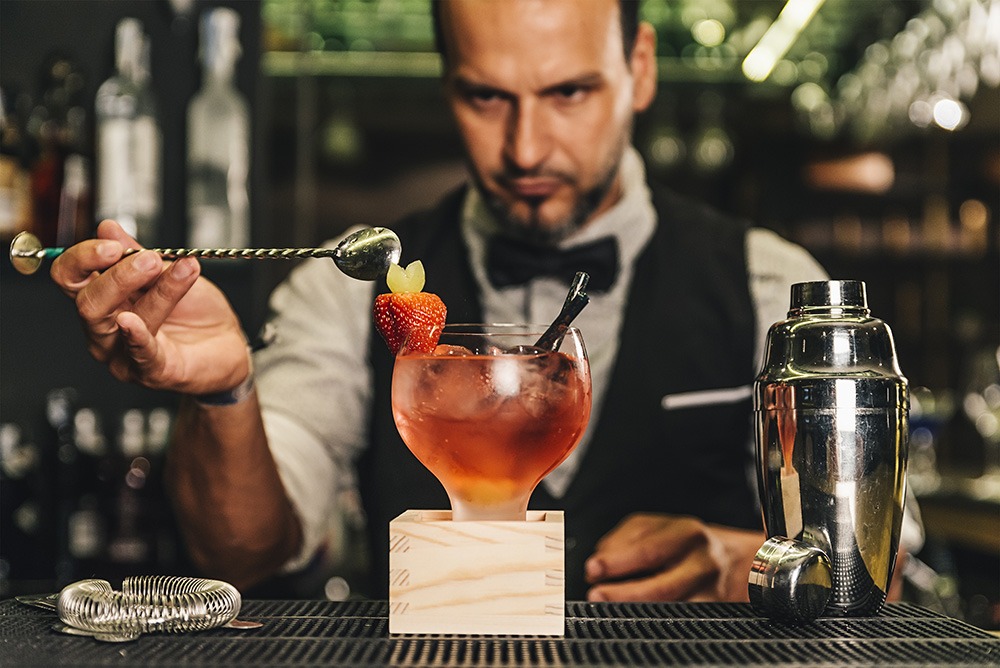I’m sitting here in front of my computer, drinking my second vodka and tonic, thinking about tips I can write about Mixology. I’m also wishing I had some cranberry juice, so that I could make a Cosmo, one of my favorite cocktails.
At least I have limes.
You see, the complexity of Mixology is like a Cosmo: there are endless numbers of possibilities and wonders of taste that you can’t even imagine in a glass filled with ice, different types of booze, and a bit of cranberry juice.
And don’t forget the lime! That’s my first tip.
Science, Art, or Both?
You see, Mixology is a science that anyone can do. Okay, actually it’s more of an art that anyone can do. All right, it’s an art and a science that anyone can do. It’s like both, because both art and science involve experimenting, and science in particular involves mixing, and a Cosmo is better mixed than shaken, unlike James Bond’s favorite cocktail.
But back to my Cosmo… uh, I mean vodka and tonic. Oh, hell, maybe I just ought to go out and buy some cranberry juice!
Back to the Mixology
In any case, some tips on basic drinking, uh, I mean drink mixing rules.
Rule Number One
Now, the first rule about mixing cocktails is: you don’t talk about mixing cocktails. Oh wait… that’s the rule about fight club, not cocktails
It’s kind of like my relationship with my last girlfriend. Bittersweet.
Actually, that’s what makes a Cosmo so good. The bitterness of the cranberry with the sweetness of the Triple Sec and the sour of the lime, which is pretty much how that relationship ended. Sour.
Mixology Fundamentals
I love to cook, and Mixology’s a lot like cooking.
(Okay, hold on, need to make myself another cocktail.)
It’s about the ingredients, and although watered-down cranberry juice mixed can still make a decent tasting Cosmo, that’s not how you make a Cosmo. It’s got to be made with 100% cranberry juice, and real, fresh limes for the juice, the more lime in your cocktail the better. And although you can use cheap vodka , a decent brand will ensure it tastes better and goes down more smoothly. You need fresh ingredients to become a Mixology expert.
Also, my next Mixology tip involves tonic water and other bubbly beverages that mix well in any cocktail. I’ve got plenty of tonic water, but it seems I’ve now run out of vodka.
Yes, you can take the edge off a cocktail that’s come out too strong with any carbonated beverage. A mimosa uses champagne. A shandy uses beer. A gin (or vodka) and tonic uses tonic water. A mojito uses soda water. A rum and Coke uses… you get the idea.
Bubbles make cocktails look pretty, and any master of Mixology can tell you that’s another good tip.
The History of the Cocktail
A bit of Mixology history now.
Remember this year: 1860. It was the year that How to Mix Drinks came out, a book that Mixologists hail as inventing the cocktail. Prior to that, apparently, everyone just drank uninteresting drinks like wine, beer, or rum. Why do I mention rum? Because British sailors begin mixing their rum with lime juice to stave off scurvy, a disease occurring due to vitamin C deficiency.
You see, cocktails and the science of Mixology begin as medicine. So your bartender is not just your friend, he’s your pharmacist!
[widget id=”text-3″]
But cocktails only really took off in the 1920s in the US, during Prohibition. Wine and beer were bulky in comparison to spirits, more bang for the buck, and so it was more financially rewarding to distill liquor, and less time consuming, than to wait for wine or beer to ferment. To take the edge off, cheap liquor was mixed into fruit juices or other beverages to make cocktails.
Bartenders became alchemists of taste, professionals whose scientific methods served the palates of law-breaking drinkers in speak easies. And thus Mixology was born.
Modern Mixologists
The Cosmopolitan, as it is properly known, is more of a modern invention, invented in New York in 1987. It’s a mixture of vodka, triple sec, cranberry juice, and lime. These ingredients are mixed to make it stronger (more vodka), sweeter (more triple sec), bitterer (more cranberry juice), or sourer (more lime). But it’s really up to the tastes of the drinker.
And remember this tip always when making a Cosmo or any other cocktail, the complexity of Mixology is like a Cosmo, there are endless possibilities and wonder in this cocktail, drinkable down to the last drop.
And now, my friends, I must go… I’ve decided I need some more vodka, and cranberry juice, as I’ve got quite a thirst for a Cosmo, so calling out for an Uber.

